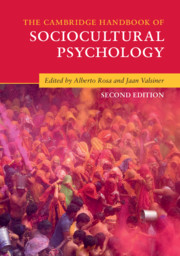Book contents
- The Cambridge Handbook of Sociocultural Psychology
- The Cambridge Handbook of Sociocultural Psychology
- Copyright page
- Contents
- Figures
- Tables
- Contributors
- Editors’ Introduction
- Part I Theoretical and Methodological Issues
- 1 The Human Psyche Lives in Semiospheres
- 2 Cultural Psychology as the Science of Sensemaking: A Semiotic-cultural Framework for Psychology
- 3 Knowledge and Experience: Interobjectivity, Subjectivity, and Social Relations
- 4 “Mediationism” in Cognitive and Social Theory
- 5 Sociocultural Psychology and Interpersonal Psychoanalysis: The Semiotic Space in the Consulting Room
- Part II Action, Objects, Artifacts, and Meaning
- Part III The Agent Rises a Reflective Self: Education and Development
- Part IV Institutional Artifacts for Value
- Part V Aesthetic and Religious Experiences
- Part VI Practices and Artifacts for Imagining Identity
- Part VII Experiences Make the Person
- General Conclusion
- Index
- References
4 - “Mediationism” in Cognitive and Social Theory
from Part I - Theoretical and Methodological Issues
Published online by Cambridge University Press: 25 June 2018
- The Cambridge Handbook of Sociocultural Psychology
- The Cambridge Handbook of Sociocultural Psychology
- Copyright page
- Contents
- Figures
- Tables
- Contributors
- Editors’ Introduction
- Part I Theoretical and Methodological Issues
- 1 The Human Psyche Lives in Semiospheres
- 2 Cultural Psychology as the Science of Sensemaking: A Semiotic-cultural Framework for Psychology
- 3 Knowledge and Experience: Interobjectivity, Subjectivity, and Social Relations
- 4 “Mediationism” in Cognitive and Social Theory
- 5 Sociocultural Psychology and Interpersonal Psychoanalysis: The Semiotic Space in the Consulting Room
- Part II Action, Objects, Artifacts, and Meaning
- Part III The Agent Rises a Reflective Self: Education and Development
- Part IV Institutional Artifacts for Value
- Part V Aesthetic and Religious Experiences
- Part VI Practices and Artifacts for Imagining Identity
- Part VII Experiences Make the Person
- General Conclusion
- Index
- References
- Type
- Chapter
- Information
- The Cambridge Handbook of Sociocultural Psychology , pp. 63 - 77Publisher: Cambridge University PressPrint publication year: 2018



